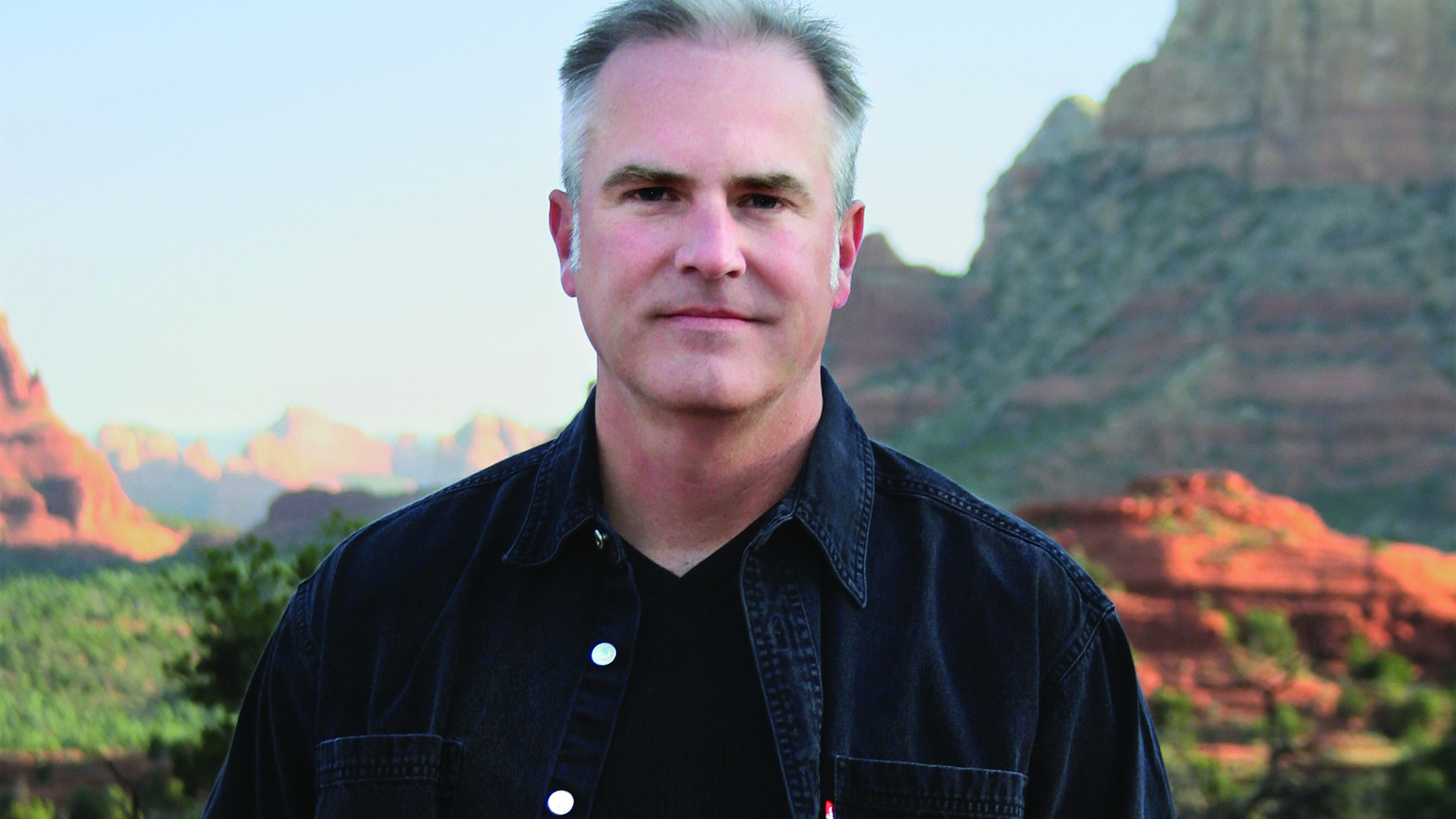

Greg Lilly in Sedona (photo by Mike Blevins)
Greg Lilly was one of the volunteers on the original planning committee for “The Wolf Crystal,†the Virginia Highlands Festival’s newest kinetic art project. He was tasked to write the story that provides the framework for the kinetic art project. Lilly is a member of the A! Magazine for the Arts editorial committee. Here are his thoughts on developing “The Wolf Crystalâ€
When the Virginia Highlands Festival’s kinetic arts team first started talking about incorporating an element of Abingdon history into the project, I thought of the 1760 story of Daniel Boone passing through this region. Legend has it that while Daniel Boone and his party camped near the creek at the foot of what is now Courthouse Hill, his dogs wandered through the walnut, oak and maple trees then returned in a rush as a pack of wolves chased them away from the wolves’ cave on the opposite side of the hill. Boone called the place Wolf Hills from then on.
To use the legend in a contemporary story with kinetic elements, we needed something residents and visitors could identify with.
All good stories start with “What if?†What if wolves still lived in the cave system under Abingdon? What secrets would they guard? What would happen if that treasure was stolen from them? This was the basis of “The Wolf Crystal.†The hero would be a young wolf pup named Abbi.
The other component is creating a villain. With an iconic and classic hero of a wolf, that embodies nature, instinct, and loyalty, we needed a modern villain who would be manufactured, technological and fickle. I see people on beautiful days, sitting in an outdoor café with friends, and everyone at the table has their heads down tapping at their phones. An incredible summer afternoon in Appalachia with a light breeze, birds chirping, sunlight filtered through the leafy canopy overhead … And no one at the table has seen it because of the snare of technology. That is the villainous concept embodied in the character Glow and his henchmen the Screen Heads.
A basic story form is [main character] wants [goal] because [motivation] but faces [conflict]. Working with Becky Caldwell, DeeDee Cole, Brian and Marie Bridgeforth, Nathan Hamilton, Heather Eisenhart and the other team members, we brainstormed on the tale and came up with this solid hero’s journey.
Abbi wants to return the Wolf Crystal to the pack because the crystal balances nature with its energy, and without that energy, the natural world begins to die. But the crystal is held by Glow and his Screen Heads to redirect its power to their technology. Abbi must use all her instincts, new friends and alliances to rescue the crystal and restore the balance of nature.
I wrote out the story in book form. To create the kinetic puppetry and robotics live theater side, I divided the story into modules that festival visitors can experience in person.
I’m not anti-technology, especially since that was my focus at Virginia Tech. Technology plus real experiences enhance life. The story of “The Wolf Crystal†can be experienced in combination with the other art forms the team created: Marie and Brian Bridgeforth’s online animation, the novella I wrote with the Bridgforth’s illustrations, and/or the live action theater.
This process reinforced the value of teamwork for me. Writing is a solitary pursuit. The ability to bounce ideas with a team of innovative people is invaluable for expanding my own creativity.
Lilly’s book, “The Wolf Crystal,†will be available for purchase in the youth park during the Virginia Highlands Festival, July 26 through Aug. 4.
About Greg Lilly
Lilly grew up in Bristol, Virginia, graduating from John S. Battle High School and Virginia Tech. He moved to Charlotte, North Carolina, to work in the Information Systems division of Belk Department Stores’ headquarters.
The rich storytelling tradition of the South captivated him, and he began writing. He first turned to creating short stories after plot lines and characters emerged from the technical manuals he wrote for Belk. His Derek Mason Mystery series grew from those Charlotte experiences.
To escape the city and find a slower pace, he relocated to Sedona, Arizona, for several years. During that time, he published two novels that chronicled adventures of the high desert, present and past.
His non-fiction book, “Sunsets & Semicolons, a Field Guide to the Writer’s Life,†shares his experiences and techniques, things that worked, not in academia or in New York City, but in the real world of freelancing and query letters and book signings. He has presented workshops and served on panels at the College of William & Mary’s Christopher Wren Association, the Virginia Festival of the Book, the Virginia Writers Club, the World Bank in Washington D.C., Malice Domestic, Bouchercon and the Sedona Arts Center in Sedona, Arizona. The kernel of the book came from requests for his workshop handouts and notes.
His latest novel, “Stray,†follows a son searching for his womanizer father who left almost 30 years before, a daughter grasping for her distant mother and the shadows cast on them by the Lost Colony of Roanoke and Virginia’s witch trials.
Lilly is a freelance writer, magazine editor, as well as a former arts and culture commissioner for the City of Sedona, Arizona, and for the Williamsburg Area Arts Commission. He founded the Williamsburg Book Festival, now in its seventh year. Today, he writes and lives in Abingdon, Virginia.
For more information about Lilly, visit www.greglilly.com.
THERE'S MORE:
Becky Caldwell leads the Wolf Crystal team